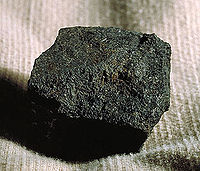
Photo from wikipedia
Abstract Bed particle agglomeration and ash deposition in a 0.2 t/d circulating fluidized bed (CFB) gasifying high sodium Zhundong lignite (ZD) at different air equivalence ratios (ERs) were experimentally investigated. With… Click to show full abstract
Abstract Bed particle agglomeration and ash deposition in a 0.2 t/d circulating fluidized bed (CFB) gasifying high sodium Zhundong lignite (ZD) at different air equivalence ratios (ERs) were experimentally investigated. With quartz as bed material in the CFB at 900 °C, ZD within 3 mm in size was fed into the furnace and gasified at ERs 0.73–0.33. Two air-cooled probes were inserted in the furnace chamber (P1) and placed at the cyclone outlet (P2) respectively to simulate ash deposition. The bottom ash (BA), fly ash and ash deposited on probes were collected and analysed by using XRD, SEM-EDS, and an ash fusion analyser. At ER0.73 during gasification, agglomerates of bed particles were observed, since low melting-points sodium silicates sticking the bed particles together. Meanwhile, in the presence of NaFeSi2O6 and sodium silicate, char particles were found to have been coated by quartz and ash particles. Independent temperature-programmed ESEM imaging analysis showed these minerals became molten even at 800 °C, confirming their low melting-points. Agglomeration in BA became even severe as ER decreased, suggesting an aggravated agglomeration tendency. The fly ash mainly composed of calcium sulphate and Na-bearing minerals, whose morphological and mineralogical features were independent of ERs. In addition, ash deposited on P2 under all gasification conditions was found to be rich in Na2SO4. However, the contents of NaCl and unburned carbon increased significantly as ERs decreased. This decreased the sintering tendency of deposited ash but promoted corrosion of the P2 probe tip as observed.
Journal Title: Journal of The Energy Institute
Year Published: 2021
Link to full text (if available)
Share on Social Media: Sign Up to like & get
recommendations!